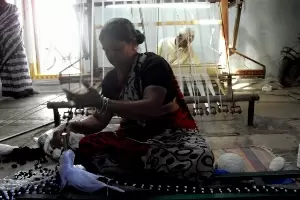Unravelling the mystique of Pochampally’s intricate Ikkat designs

28-January-2011
Vol 3 | Issue 4
Stooping to enter the low roof hut, one spots Bharatha Ramadas, in his vest, hunched up on the cold granite floor, transforming silk yarn into a fabulous new design. Next to him lies a drawing of an intricate pattern of leaves spiralling up the stalk of a creeper – it is the new design he has created for an Ikkat Saree.
The rest of the hut is dark and shadowy but Ramadas sits bathed in natural light from an intriguing opening in his roof. It makes one wonder if the natural glow surrounded by darkness is a metaphor of the village, Pochampalli, itself. The village, which is geographically situated 45 km from Andhra Pradesh’s capital city of Hyderabad, has a place in Indian history, too. Famous for its traditional weavers and the Ikkat saris they make, Pochampally is the place where the famous national Bhoodan (land donation) movement, led by Acharya Vinobha Bhave, was born in 1951.
 |
|
Old passion: Pochampally in Andhra Pradesh is famous for families that weave intricately designed Ikkat sarees.
|
Vinobha Bhave, after the conclusion of the Sarvodaya Conference in Shivarampally, visited Pochampally as part of his walk through Telengana, which was then a nerve centre of intense communist activities over land distribution.
As Vinobha walked through the village, 40 landless families of what was considered the lowest caste, surrounded him and explained that only if they were given land, could they be helped out of poverty.
Vinobha felt helpless but during a prayer meeting he held later that day he spoke about the problem which the 40 families faced. The prayer meeting drew thousands of villagers from across the state. Without expecting any response, Vinobha said, “Brothers, is there anyone among you who can help these 40 families?”
Vedire Ramachandra Reddy, a rich farmer, stood up and said, “I am ready to give 100 acres to these families!” Vinobha was further astounded that the families accepted only 80 acres at 2 acres each and would not accept the rest.
As the story goes, over the next seven weeks during his Telengana walk, he collected 12,000 acres and this movement in turn spread across the country as the famous Bhoodan Movement.
The land can never be sold and Ramadas inherited the land from his ancestors. “This hut will be over 50 years old and my ancestors had the foresight to plan our huts so that we worked with natural light to safeguard our eyes. Ours is very intricate work and even with all the care we take with our eyes, most of us lose our sight in our mid forties,” explains Ramadas, who is in his early forties.
He is busy working over silk yarn which is stretched on a frame, tying rubber strips to it. The whole process is very intricate. “It takes three days for me to make a simple design, but a week for this kind of intricate pattern,” he reveals.
As Ramadas works on the loom, with the spindle flying up and down deftly between the threads, a grey piece of cloth is placed over his creation as a cover from dust. As he lifts the grey cloth, one is stunned at the softly glowing pearl grey silk saree with a bright vermilion border.
If such beautiful creations have survived the many changes in society and still has people marvelling at its intricate workmanship, much of the credit goes to Vinobha Bhave, whose movement gave the artisans their own land to live in.
Marianne de Nazareth visited Pochampally as a media fellow under the aegis of the IASC 2011















